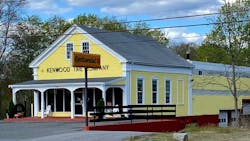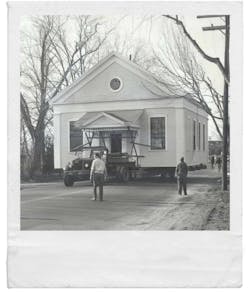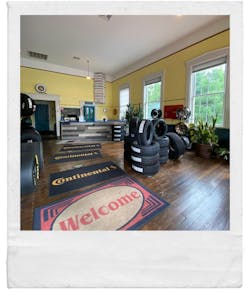Every day at Kenwood Tire Company, the past and the present blend together.
Daily business specials appear on an original chalkboard from a 19th-century schoolhouse in West Bridgewater, Massachusetts. Squeaky wooden floorboards in theEarlier this year, owner Spencer Carruthers spotted a signature from 1883 on an attic roof truss, presumably scribbled by a construction worker.
“It’s the building that keeps on giving,” Carruthers says. “It’s such a piece of history in this community. It’s creaky and sometimes challenging, but’s still going strong.”
While Kenwood Tire has an entirely modern shop–plus 21st-century customer perks such as Wi-Fi and phone-charging stations–its counter, showroom and waiting room occupy the oldest part of the structure.
Carruthers’ artist wife, Holly Carruthers, has decorated those areas with eclectic paintings, vintage black-and-white photographs and plenty of plants, including an orchid cactus passed down from her great-grandmother.
So how did a family-owned tire business end up in a former school/library about 35 minutes from Plymouth, Massachusetts, where the Pilgrims landed in 1620? And how did Spencer Carruthers, who grew up in England and planned to be a land surveyor, end up managing it?
Spotting a potential deal, Wood offered to buy the 2,050-square-foot structure from West Bridgewater and move it to land he owned nearby, thereby sparing the town any expenses. The purchase price: $1.
On a cold December day, adults and children lined the streets to watch the building travel about a half-mile on a towed flatbed to Kenwood Tire’s current location. Town officials had carefully mapped out a route to avoid hitting trees, overhead wires and fire hydrants.
Wood, who eventually operated several other (since-sold) tire shops in Massachusetts, added enough square footage for three service bays, offices and warehouse space. Today, the yellow shop has three levels and is about 5,000 square feet.
Wood’s daughter Holly, meanwhile, met Spencer Carruthers in 1989 when she was a student at Syracuse University and traveled to London for an art class. After she left, they exchanged letters and she visited him in South Africa, where his parents had moved.
In 1991, Spencer came to see Holly in the United States on a three-month visa. During his stay, he helped Wood with painting at his shop and began to learn the tire trade from the ground up, starting with changing tires.
Back then, the building had no heat; employees often changed tires in freezer suits. Technicians communicated with counter staff by hitting a metal support column with a wrench, twice to signal that a vehicle was done and three times to ask for help.
While Spencer was in the country, Wood grew ill with cancer. Since Spencer knew“Life changed fast, but it was all great,” Spencer recalls. “This was an accidental career that I’ve always enjoyed, especially the customer service side of it.”
Wood died in 1997, and Spencer and Holly have owned Kenwood Tire since 1999. With three technicians, the company specializes in tires, alignments, brakes and oil changes. Spencer has assumed the bulk of daily management duties, with Holly handling bank deposits.
“The fact that it’s still in my family, with my dad’s name on it, is so cool,” Holly shares. “It could have been reduced to rubble or sold and turned into something very different.”
Holly keeps a studio on the third floor of the shop, which has hosted art shows through the years. She also displays her collection of antique photographs called “yard-longs”, or rectangular images of groups of people such as policemen or construction workers; some are more than 100 years old.
“They suit the history of the building,” Holly notes. “I want it to have a cozy but quirky feel.”
Another of Holly’s interests is horticulture, and she has brought about 20 tropical plants into the well-lit showroom. According to family lore, one cactus traveled from Sweden with Holly’s great-grandmother when she immigrated to America in the mid-1800s.
“It was something her mother had given her, so one of her most prized possessions,” Holly relates. “It blooms with these beautiful bright red flowers that are, for me anyway, another nice connection to the past.”
“A couple years back, I had a contractor nail down the floorboards in the waiting room because the squeaking was driving me nuts,” Spencer says with a laugh.
Spencer and Holly have a 26-year-old daughter who recently got married, although no apparent family heir to the business yet. But at age 56 and 58, respectively, they have no plans to leave their successful tire shop anytime soon.
Make that their school-library-tire shop.
“The history and just the surprise of how we look are good talking points,” Spencer says. “In the tire business, you’ve got to be memorable and trustworthy, and I think this all helps people feel we’re both.”




